Ozone-depleting substances and the greenhouse gases HFCs, PFCs and SF
1 Summary
1.1 Ozone-depleting substances
ODP-weighted consumption for 2005 based on reporting from importers has been calculated at 1.76 ODP tonnes, a further reduction of 1.07 ODP tonnes compared to 2004, when consumption was 2.83 ODP tonnes.
Due to this, Statistics Denmark registered imports of 14.2 tonnes of CFC-12 in 2005. Import of CFC-12 is banned and therefore this registration is undergoing an investigation to clarify whether the import is actual or it is coursed data failure.
The table below shows ODP-weighted consumption calculated on the basis of information on imports from importers and producers. The ODP values are listed in Appendix 1, Table 1.a.
Table 1.1 Overview of consumption and ODP-weighted consumption in 2002-2005, Tonnes
(1) In the calculation of the ODP-weighted consumption of CFCs, CFC-113 is the only substance which has been reported and which is included in the calculation basis.
Danish consumption of methyl bromide has only been used as feedstock for other chemical production. Therefore it is not included as an emission.
CFCs, tetrachloromethane, and trichloroethane are used exclusively for laboratory purposes.
HCFCs are used as refrigerants or for foam production (system foam). The areas of application of HCFCs in 2005 are shown in Table 1.2.
Table 1.2 Consumption of HCFCs by application area in 2005, tonnes.
| Application area | HCFC-22 | HCFC-123 | HCFC-141b | HCFC-142b |
| System foam (for panels, insulation, etc.) | 0 | 0 | 13.4 | 0 |
| Refrigerants, New | 0 | 0 | 0 | 0 |
| Refrigerants, regenerated | 95.6 | 0 | 0 | 0 |
| Refrigerants, HFC mixtures | 5.3 | 0 | 0 | 0 |
| Total | 100.9 | 0 | 13.4 | 0 |
Only regenerated HCFC-22 is used as a refrigerant in Denmark and import of new HCFC-22 is exported to other countries for use as refrigerant. Regenerated HCFC-22 is not included in calculation of the ODP weighted consumption.
HCFC-141b is used in foam production
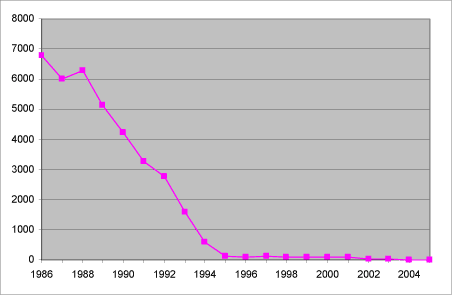
Figure 1.1 The development of ODP-weighted consumption 1986-2005, tonnes.
The specific consumption figures for individual substances and groups of substances and the ODP contribution calculated for the period 1992-2005 appear in Table 3.1 in Chapter 3.
1.2 F-gases
The GWP-weighted actual emissions of HFCs, PFCs, and SF6 in 2005 were 839,5 thousand tonnes CO2 equivalents. The corresponding emissions were 796,8 thousand tonnes CO2 equivalents in 2004, as reported in /13/. Thus, the consumption of HFC has decreased with approx. 150 tonnes in 2005 compared to 2004. The increase in the GWP-weighted actual emission is first of all an effect of historical consumption in refrigeration systems which have a large amount of refrigerants in stock.
In Table 1.3 below, consumption, actual emissions and stock in products are summarised after making adjustments for any imports and exports of stock in products.
Table 1.3 Consumption, actual emissions, stock, adjusted for imports/exports as well as GWP contribution from greenhouse gases 2005, tonnes.
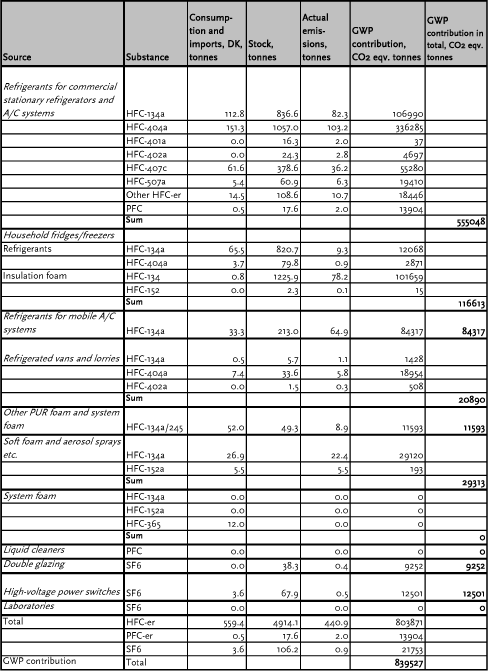
In Figure 1.2 below, total GWP contributions from HFCs, PFCs, and SF6 are shown in relation to individual sources. The figure shows the sources responsible for individual contributions in 2005.
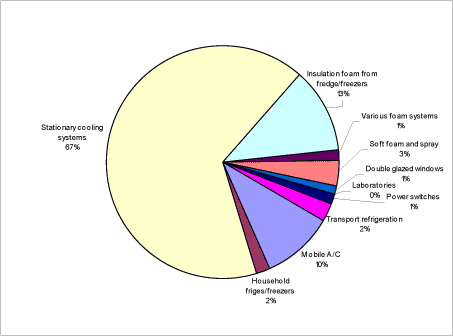
Figure 1.2 The relative distribution in 2005 of GWP contribution, analysed by source
The figure shows that emissions from refrigerants used in commercial stationary refrigerators account for the largest GWP contribution. These refrigerators cover 66,1 per cent of the total actual contribution in 2005. The contribution is primarily from HFCs, and a small part is from PFCs.
The second-largest GWP contribution, accounting for 12.1 per cent, comes from ongoing releases of HFCs from insulating foam and insulation foam in fridges and freezers.
Mobile A/C contribute with 10 per cent and 3.5 per cent of the GWP contribution stems from HFC emissions released during the production of soft foam and from the use of HFC-based aerosol sprays.
The two sources of SF6 emissions in 2005 were power switches and double glazing windows. These account for 2.6 per cent of the total GWP contribution.
HFCs comprise around 95.8 per cent of the overall GWP contribution in 2005. Emissions of SF6 comprise 2.6 per cent and emissions of PFC contribute with 1.7 per cent to the total contribution.
The relative distribution is shown in Figure 1.3 below.
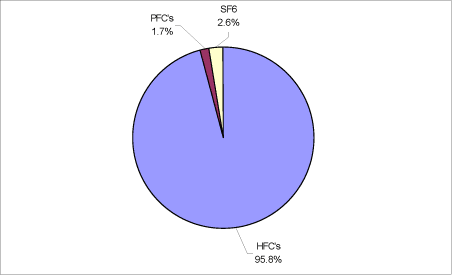
Figure 1.3 The relative distribution of the GWP contribution from HFCs, PFCs, and SF6, 2005.
1.2.1 HFCs
In 2005, the total import (minus re-export) of pure HFCs was approx. 553.7 tonnes. When including import of R 413 and R 417 HFC blends, the total netto import of pure HFC’s are 559.4 tonnes. Compared to 2004, when total consumption was approx. 711.5 tonnes, the import is decreased.. There are reductions for almost all HFCs. Only import of HFC-245 has increased.
Actual emissions from HFC’s have been calculated to approx. 803,9 thousand tonnes CO2 equivalents. In 2004, emissions were 747,7 thousand tonnes CO2 equivalents. It is an increase of approx. 55,000 tonnes CO2 equivalents
The actual emission from HFC’s has exceeded to highest level since HFC’s has been introduced.
1.2.2 Sulphur hexafluoride (SF6)
The consumption of sulphur hexafluoride was 3.58 tonnes in 2005, which is an increase of approx. one tonnes compared to 2004.
Actual emissions have been calculated at 0.9 tonnes, equivalent to a GWP contribution of 21.7 thousand tonnes CO2 equivalents. In 2004, emissions were 33.1 thousand tonnes CO2 equivalents.
1.2.3 Per fluorinated hydrocarbons (PFCs)
In 2005, the consumption of per fluorinated hydrocarbons (per fluoropropane), which are used exclusively in the refrigerant R413a, was 0.5 tonnes. The actual GWP-weighted emission from stock containing R413a and consumption is 13.9 thousand tonnes CO2 equivalents, which is a continuation of the reduction since 2002.
1.2.4 Trends in total GWP contribution from F-gases
Figure 1.4 shows the trend in Danish GWP contributions 1992-2004 from HFCs, PFCs, and SF6. The differences from the present calculations of the total GWP value compared with earlier calculation methods are illustrated in the figure.
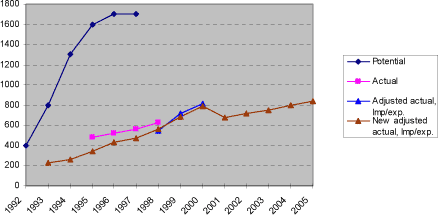
Figure 1.4 Trends in GWP-weighted potential, actual and adjusted actual emissions 1992-2005, 1000 tonnes CO2 equivalents.
The figure shows that the GWP emission also in 2005, has increased and now the emission from F-gases has exceeded the highest level ever.
The development in the GWP contribution 1992-2005 can also be seen in Table 1.4 below.
Table 1.4 Total GWP-contribution from HFCs, PFCs, SF6, 1000 tonnes CO2 equivalents, determined according to the four different methods of calculation applied during this period
| Potential | Actual | Actual, adjusted imp/exp. |
New actual, adjusted imp/exp. |
|
| 1992 | 400 | |||
| 1993 | 800 | 230 | ||
| 1994 | 1300 | 263 | ||
| 1995 | 1600 | 480 | 344 | |
| 1996 | 1700 | 520 | 435 | |
| 1997 | 1700 | 560 | 472 | |
| 1998 | 625 | 577 | 564 | |
| 1999 | 700 | 683 | ||
| 2000 | 818 | 793 | ||
| 2001 | 699 | |||
| 2002 | 719 | |||
| 2003 | 745 | |||
| 2004 | 797 | |||
| 2005 | 839 |
Version 1.0 February 2007, © Danish Environmental Protection Agency